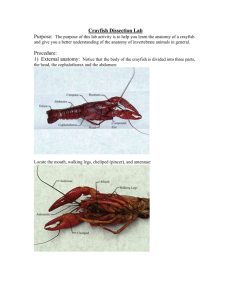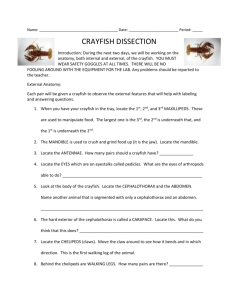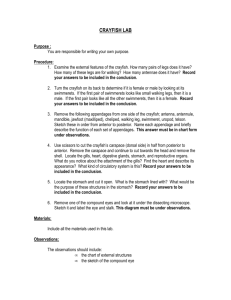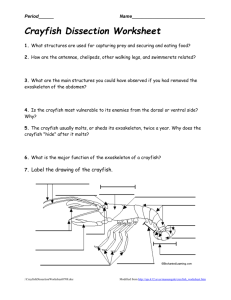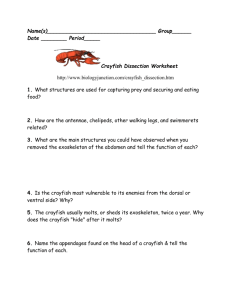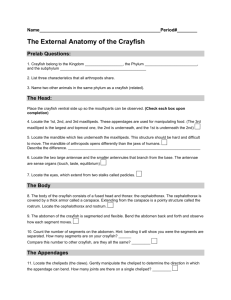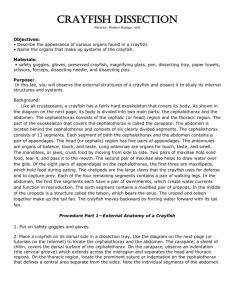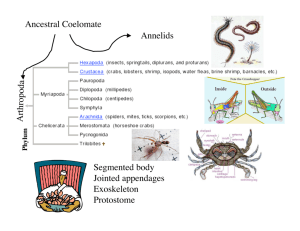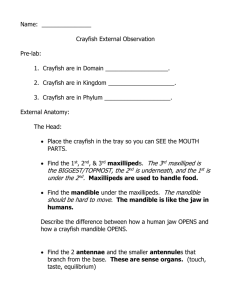Frog Dissection
advertisement
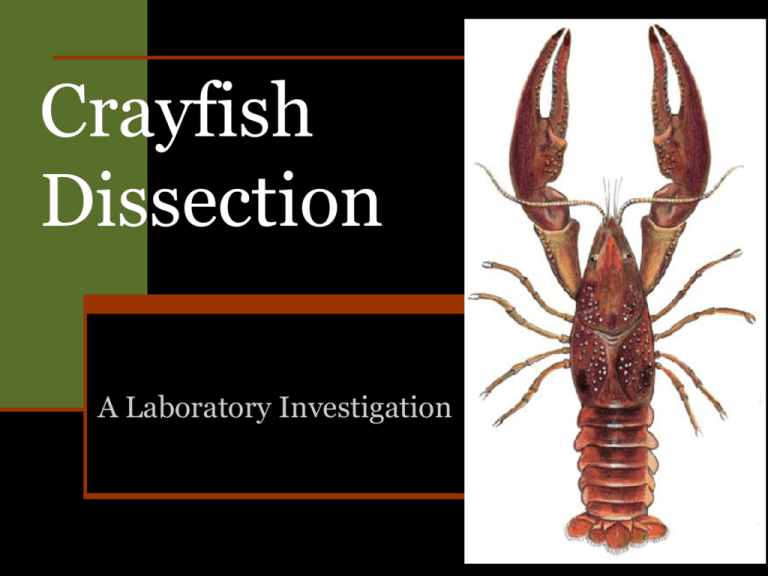
Crayfish Dissection A Laboratory Investigation Part 1— External Anatomy of a Crayfish 1. Place a crayfish on its ventral side in a dissection tray. 2. Use the diagram below to locate the cephalothorax and the abdomen. 3. The carapace, a shield of chitin, covers the dorsal surface of the cephalothorax. 4. On the carapace, observe an indentation, the cervical groove, that extends across the mid-region and separates the head and thoracic regions. 5. Note the individual segments of the abdomen. 1. 2. 3. Turn the crayfish on its side, and locate the rostrum, Beneath the rostrum locate the two eyes. Locate the five pairs of appendages on the head region. First locate the antennules in the most anterior segment. Behind them observe the much longer pair of antennae. 1. 2. Locate the mouth. Then observe the mandibles, or true jaws, behind the antennae. Now locate the two pairs of maxillae, which are the last appendages in the cephalic region. Maxilla Mandibles 1. On the thoracic portion of the cephalothorax, observe the three pointed maxillipeds. 1. Next observe the largest prominent pair of appendages, the chelipeds, or claws. Behind the chelipeds locate the four pairs of walking legs, one pair on each segment. 1. 2. 3. On the abdomen, observe the six distinct segments. On each of the first five segments, observe a pair of swimmerets. On the last abdominal segment, observe a pair of pointed appendages modified into a pair of uropods. In the middle of the uropods, locate the triangular-shaped telson. Now turn the crayfish ventral side up. Observe the location of each pair of appendages from the ventral side. Part 2— Internal Anatomy of a Crayfish Using one hand to hold the crayfish dorsal side up, use scissors to carefully cut through the back of the carapace along dissection cut line 1, as shown in the diagram below. 2. Cut along the indentations that separate the thoracic portion of the carapace into three regions. 3. Start the cut at the posterior edges of the carapace, and extend it along both sides in the cephalic region. 4. Use forceps to carefully lift away the carapace. 1. Place the specimen on its side, with the head facing left, as shown in the diagram below. 1. Using scissors, start cutting at the base of cut line 1. 2. Cut along the side of the crayfish, as illustrated by cut line 2. Extend the cut line forward toward the rostrum (at the top of the head). 1. Use forceps to carefully lift away the remaining parts of the carapace, exposing the underlying gills and other organs. Use the diagram below to locate and identify the organs of the digestive system. 1. Locate the maxillae that pass the pieces of food into the mouth. The food travels down the short esophagus into the stomach. 2. Locate the digestive gland, which produces digestive substances and from which the absorption of nutrients occurs. 3. Undigested material passes into the intestine. Observe that the intestine is attached to the lobed stomach. 4. The undigested material is eliminated from the anus. Use the diagram below to locate and identify the organs of the respiratory system. 1. Locate the gills, which are featherlike structures found underneath the carapace and attached to the chelipeds and walking legs. A constant flow of blood to the gills releases carbon dioxide and picks up oxygen. Use the diagram of the internal anatomy of the crayfish to locate and identify the organs of the circulatory system. 1. Locate the dorsal tubular heart and several arteries. The crayfish has an open circulatory system in which the blood flows from arteries into sinuses, or spaces, in tissues. The blood flows over the gills before returning to the heart. 1. Locate the dorsal brain, which is located just behind the compound eyes. Note the two large nerves that lead from the brain, around the esophagus, and join the ventral nerve cord. Identify the organs of the excretory system. 1. The blood carries cellular wastes to the disk-like green glands. Locate these organs just in front of the stomach. The green glands excrete waste through pores at the base of each antenna. Identify the organs of the reproductive system. 1. If your specimen is a male, locate the testis. The testis is the long, white organ under the heart and a bit forward. The sperm ducts that carry sperm from the testis open at the fifth walking leg. 2. If your specimen is a female, locate the bi-lobed ovary. It is in the same relative position as the testis, but the ovary appears as a large, yellowish mass under the heart. 1. What structures are used for capturing prey and securing and eating food? 2. How are the antennae, chelipeds, other walking legs, and swimmerets related? 3. What are the main structures you could have observed if you had removed the exoskeleton of the abdomen? 4. Is the crayfish most vulnerable to its enemies from the dorsal or ventral side? Why? 5. The crayfish usually molts, or sheds its exoskeleton, twice a year. Why do you think the crayfish "hide" after it molts? 6. Compare what happens to digested nutrients and undigested food in a crayfish 7. Of the systems studied, which two are most unlike the related human system? Why? 8. Although the crayfish has an inflexible cephalothorax, the crayfish is classified as a segmented animal. Why? 9. What is the major function of the exoskeleton of a crayfish? How is the exoskeleton an adaptive advantage to the crayfish? APPENDAGES ANTENNA ANTENNULE MANDIBLE Touch, taste Touch, taste, equilibrium Chew food MAXILLA Manipulate food Last pair “bailers”Move water over gills Touch, taste, manipulate food MAXILLIPEDS CHELIPED WALKING LEGS SWIMMERETS UROPOD Capture food, defense Locomotion, move water over gills Move water over EGGS, transfer sperm (males) carry young/eggs (females) Propulsion during tailflips
